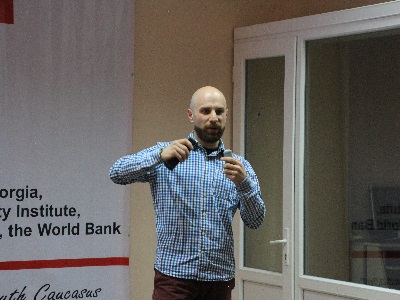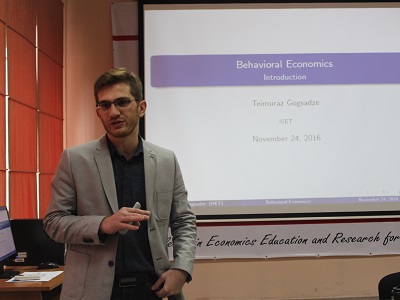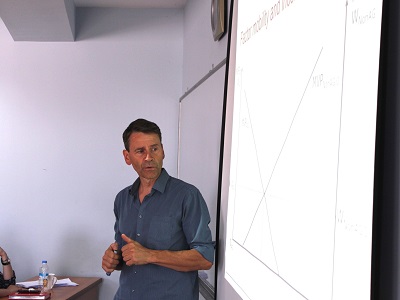On Monday, March 6 ISET hosted its graduate Robizon Khubulashvili, a PhD Student of Pennsylvania State University. Robizon presented his working paper entitled “Endogenous Team Formation Among Competitors”.
In this paper, Robizon analyzed endogenous group formation when competition among teammates is a concern. He showed an algorithm that could be used to find an equilibrium in which all the members of the competitors' group want to be in the group and want to exchange their information with every other member of the group.
Robizon also had answers to some interesting questions from group theory and organizational economics. First, he characterized conditions under which team managers should improve weak players of the team; the interesting result was that even if one player is more important than another, there is a strong incentive to improve the less important player. He also showed that team with homogeneous members have higher expected value than an average ability team with more heterogeneous members. Finally, Robizon addressed matching problems, and discussed allocation of agents in pairs.
Behavioral economics is one of the most notable fields of modern economics. It draws insights from psychology, sociology, biology, and other social sciences.
On 24th of November, ISET hosted Teimuraz Gogsadze, a graduate of the Class of 2011, who gave an introductory lecture in behavioral economics. Gogsadze started his talk by formally defining the scope of behavioral economics. He then discussed the antecedents and historical context of the field, highlighting the importance of psychological realism of assumptions in economic modelling before the start of 20th century and the gradual removal of psychology from economics during the first half of the 20th century.
On November 21, Prof. Dr. Stephan von Cramon-Taubadel gave a presentation of a working paper entitled “Trade Costs for Heterogeneous Agricultural Products” at ISET. The professor himself and Mr. Yi Qu are the co-others of the paper, which aims to evaluate trade costs for 125 different agricultural products based on 1992-2011 data from 156 different countries.
Geographic characteristics (island or mainland, number of neighboring countries, etc.), transportation (the distance products cover domestically or internationally), tariffs (on exports and imports), institutions and the history of the country, as well as demographic characteristics (the religion of the majority of the population in a particular trading partner, common language, etc.) serve a role of explanatory variables in the analyses.













